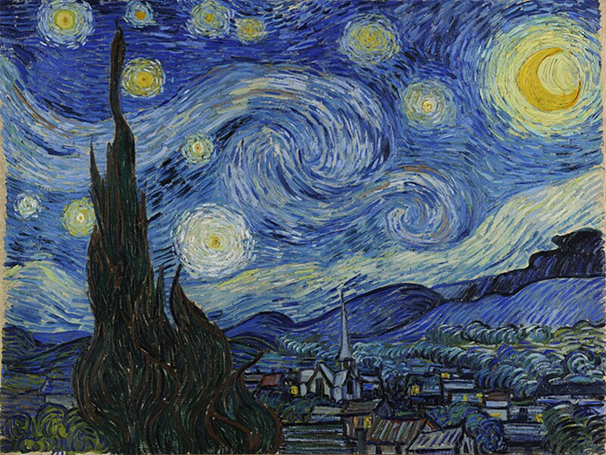
When we think of Van Gogh, immediately, we think of Starry Night.
Arguably the painter’s most famous work, Starry Night is deemed by scholars to be one of Van Gogh’s most unusual paintings. It marks a departure from his usually more realistic depictions of his favored natural landscapes, delving into its surrealism, illogical proportions, and perspectives, into a new realm and style of expression. The painting is wildly evocative, rendering it an ideal candidate for deeper exploration, as we seek to unravel the mysteries of the mind behind it.
In its sky, four clusters of light, eleven stars, and a crescent moon bathe the nighttime with their warm glow, inviting an air of amazement into the senses of the observer, echoing the painter’s known reverence towards nature’s essence. Below, a village can be seen, lit in parts but mostly hidden in shadows. The houses and church break into the natural landscape, standing far off in the distance, leaving us with a sense that the onlooker glancing at it has been ostracized from its society. The uneven darkness of the landscape, with sinister dabs of stark black paint appearing sporadically throughout the landscape, induces a muted feeling of primal fear and anxiety in the observer.
Across the horizon, a cold strike of light blue and white acts as a sharp demarcation between ground and sky, between the realms of the divine and the worldly. And above it, the element is most eye-catching; the double spiral hovers in peaceful, almost sensual turbulence. It dominates the night sky, commanding even more attention than the stars themselves. Its swirling pattern evokes a sensation of loss, of freefall, this time into the throes of violent upheaval, as it drags chunks of the night sky into an elegantly chaotic movement, equal parts beautiful and terrifying.
One last image remains to be addressed: the cypress trees. Spreading across the canvas in suffocating black and dark greens, they create a focal point for the eye to ground itself. In a sense, those trees act like a gateway to the rest of the landscape, as one often begins their visual journey across Starry Night with an initial stop at them. Their undulating branches twist and bloom out almost like flame, radiating with a peculiar energy, paradoxically inviting the observer’s interest and dread at the same time.
A connoisseur of symbolism in painting, Van Gogh’s stylized depiction of the night sky goes beyond its explicit purpose of presenting a beautiful nightly scene. It can be argued that, in its implicit sense, the painting is a self-portrait, not of the artist’s likeness, but of his psyche.
Van Gogh struggles his entire life with his mental health; suffering from an unfortunate combination of upbringing, lifestyle, and predisposition, in his adult years he is prone to chronic depression, self-destructive behavior, and intermittent psychotic breaks that terrify the painter. Throughout his short life, and in his own words, painting is his saving grace. In modern psychological study, art has a recognized therapeutic effect on people struggling with mental illness, acting as an optimal outlet for expression and mindfulness. It’s not a stretch to suppose that Van Gogh undertook an early, self-operated form of personal art therapy, always fervently reverting to painting after severe mental episodes, deeming his work as his one foolproof shield against the pain he was subjected to.
In Starry Night, Van Gogh’s psychological world comes to life upon the canvas. His suffering, the shadows of death and failure that torment him throughout his life, can be noticed in the dark cypress trees and the obscured patches scattered across the landscape, popping up at the observer’s eyes like ghosts. The far-off perspective of the painting, a scene that parallels the view from the artist’s room at the Saint Remy asylum, where he spends a year receiving care for his mental afflictions, is synonymous with the distance he chooses to uphold then between himself and society, after enduring its rejection on account of his particularities, his unconventional ways, and his ill health.
It’s no wonder the double spiral occupies the center of the painting, as it stands as the mirror of the painter’s psyche. Tempestuous and peaceful all at once, light in places, darker in others, a collective of unknown and jarring clarity, it defines the scattered and often spiraling mind of Vincent, even as it gathers into a single defining focal point at its center, a ground zero of sorts, to which it will always return. The spiral, and indeed the entirety of Starry Night, enchants us so, because through it, we’re not just experiencing a painting.
Through Starry Night, for a moment, we become Vincent Van Gogh, in all his (pain)t.